This is “Step 2: Create a Compelling Marketing Campaign, Part I: Résumé”, chapter 4 from the book Job Searching in Six Steps (v. 1.0). For details on it (including licensing), click here.
For more information on the source of this book, or why it is available for free, please see the project's home page. You can browse or download additional books there. To download a .zip file containing this book to use offline, simply click here.
Chapter 4 Step 2: Create a Compelling Marketing Campaign, Part I: Résumé
Figure 4.1 The Six-Step Job Search Process—Step 2
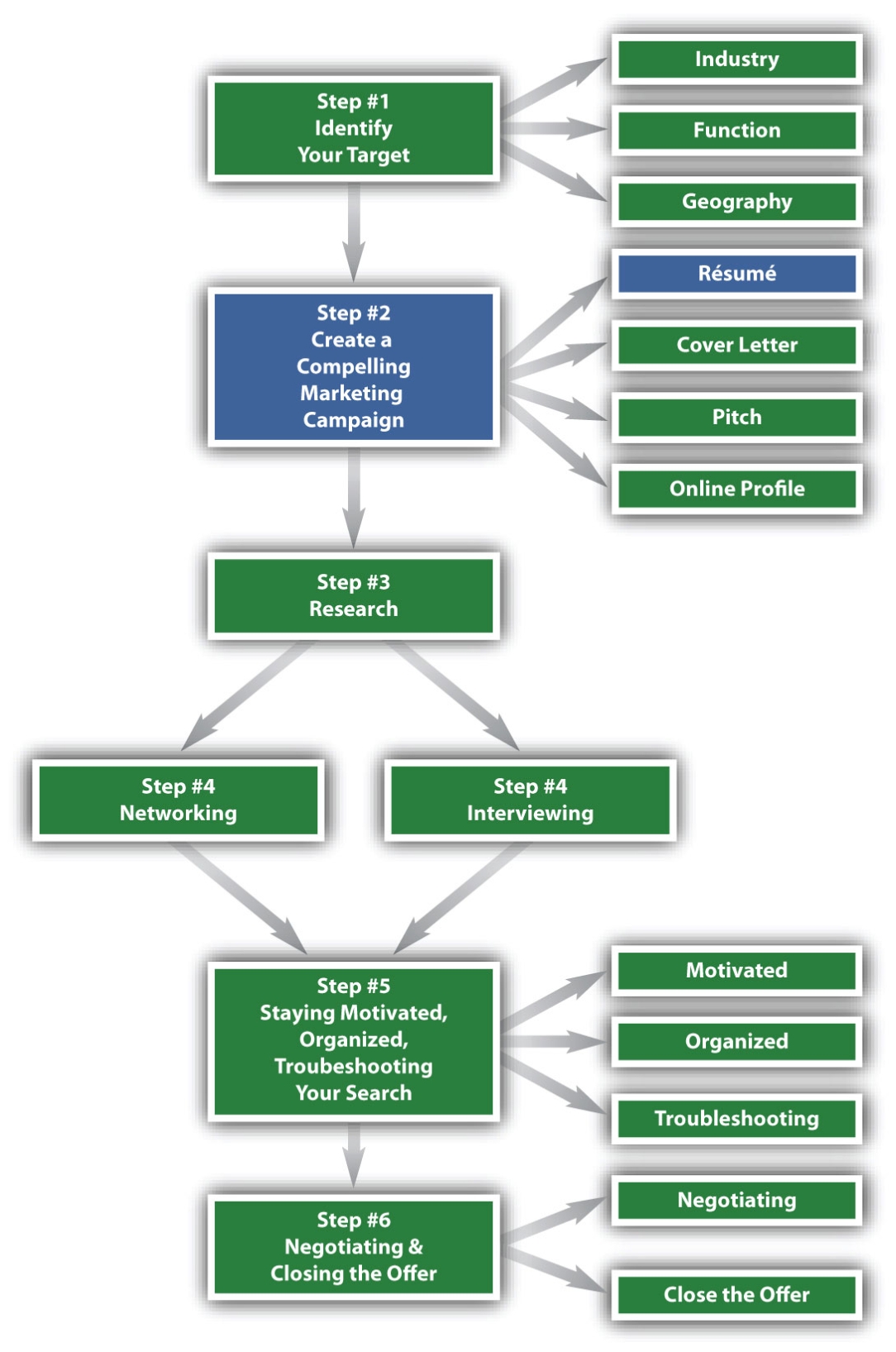
Overview
Market Yourself First with Your Résumé
At this point in your search, you have completed step 1 with a specific industry, function, and geography in mind.
Step 2 (creating a compelling marketing campaign) consists of four distinct tools that can help construct a strong, effective, and successful job search:
- Your résumé
- Your cover letter
- Your online profile
- Your pitch
This chapter will focus only on your résumé. Chapter 5 "Step 2 (Continued): Create a Compelling Marketing Campaign, Part II: Cover Letter, Pitch, and Online Profile" will complete this step, and we will then focus on the remainder of your marketing campaign: your cover letter, your pitch, and your online profile.
Marketing Focus. Your résuméA brief written account of personal, educational, and professional qualifications and experience, usually prepared by an applicant for a job. is a marketing document that sells your candidacy. It provides an outline of your educational background, your work experience, and the key skills you have acquired. Your résumé should be marketed in a format that is pleasing to read, efficient in its use of the English language, and so concise that it fits on one page. Once you have approximately ten years of experience, it is more acceptable to have a two-page résumé, but until then, you should adhere to a one-page document. Recruiters can frown on the audacityRefers to a bold move or presumption. of a college student with a two-page résumé. Whether you are not sure you can fill a one-page résumé, or whether you think it’s not possible to fit your information to only one page, this chapter will help you get to your goal: an exceptional, one-page résumé.
Quality, Clarity, and Accuracy. Your résumé is the most critical component, or cornerstone, of your marketing campaign and it must meet two important criteria:
-
Your résumé must be written in a clear and concise manner so the reader can quickly grasp what you offer as a candidate. Most seasoned recruiters scan a résumé in about seven to ten seconds, but do not let that short review time throw you. Recruiters have an eye for the key things to look for in a résumé, so a lot of care should be put into its construction. That construction should highlight the following features:
- Your strengths
- Your responsibilities
- Your accomplishments
- Your résumé must be completely error-free. A résumé represents you when you are not there. Recruiters look for reasons to reduce the number of résumés to review, so one error can be all that is needed to discard your résumé and your candidacy. This is true in both good and bad economies, so take great care to guarantee 100 percent accuracy.
Proofread your résumé several times, use spell check, and ask someone who is exceptional at proofreading to review it. Always assume that an error lurks somewhere in your résumé and review it and review it and review it until you find that error! Résumés often have the following common errors:
- Misspellings (Spell check does not catch every misspelled word; meat will not be corrected if you meant to write meet.)
- Errors in verb tense (Past experiences should be written in the past tense and current experiences in the current tense.)
- Grammatical errors of any kind
- Inconsistent formatting
- Inappropriate length
How to Craft the Perfect Résumé. This is a trick title because there is no perfect résumé. You could always choose to have a particular bullet written in ways that are grammatically correct, are results oriented, and use action verbs, but writing a résumé is not a perfect science. You could show your résumé to five different recruiters and you might get five different opinions. There is no need to worry. The important thing is that it is well-written and highlights your accomplishments (no matter how big or how not so big). It’s important that the format be consistent and that you get an opinion from a professional, whether it is someone from career services, a professor, or a person who is currently working in the field in which you are most interested.
On-Campus Recruiting. If you are participating in on-campus recruitingManaged by a college’s career services office. Specific companies will come on campus to interview candidates. Second rounds and final rounds will follow either on campus or at the employer’s offices. (when a company comes onto your campus to recruit), three interview scenarios are possible: open, closed, or a mixed schedule. The school dictates the type of schedule, and it’s important to know in which type you are participating:
- An open scheduleAllows you to drop your résumé at the career services office for the specific position in which you are interested. The company recruiter will then review all the résumés and select the top ten or twelve candidates they will interview on campus (each schedule accommodates approximately twelve individuals). allows any student to go to the career services office to drop their résumé for the specific position in which they are interested. An open schedule, therefore, is open to any candidate who wishes to be considered for an interview. The company recruiter will then review all of the résumés and select the top ten or twelve candidates they will interview on campus. (Thirty-minute interview schedules allow for twelve students to be interviewed, while forty-five-minute interview schedules allow for nine students to be interviewed.) The company will select the length of interviews when they initially book the schedule with career services.
- A closed scheduleAllows the recruiter to select the ten or twelve individuals they will interview. happens when the recruiter selects all of the ten or twelve individuals they will interview either from the résumé book, from interactions they have had on campus, or from a colleague’s recommendation. Perhaps they met a student who impressed them at a marketing event. The recruiter could choose to include that student in a closed schedule.
- Half open/half closedA hybrid of an open and a closed schedule. schedules are a hybrid of the two preceding schedules. Half the students will be selected from students who have dropped their résumés, and the recruiter will select the other half from the résumé book, a recommendation, or a direct interaction with the student while they were on campus.
Whether you drop your résumé for an open schedule or you are selected to participate in a closed schedule, the recruiting cycle is fast paced and résumés can be easily missed due to no fault of the job seeker and résumé writer. Sometimes recruiters review hundreds of résumés to find the ten or twelve they will pursue, and sometimes résumés can be missed because of something as simple as pages sticking to one another.
Should your résumé be one of the many that isn’t selected, you can write to the recruiter, using your cover letter to make a strong case for why you should be considered. In some cases, this may work to get you an interview. In other cases, it will not. You can easily be passed over for no reason.
The recruiting process is not perfect, so it’s recommended that you apply for as many positions as possible. Never rely solely on the submission of one résumé (Chapter 5 "Step 2 (Continued): Create a Compelling Marketing Campaign, Part II: Cover Letter, Pitch, and Online Profile" will give you additional strategies to get your foot in the door). Instead, when on-campus recruiting takes place, apply for all positions that fit your strengths and interests.
Off-Campus Recruiting. Don’t limit your search to only on-campus opportunities because off-campus opportunities can also be fruitful. Conducting both an on-campus and off-campus job search only increases the number of opportunities you can consider. You will want to pursue off-campus opportunities for three reasons:
- Your school does not have a robust career services department that attracts a variety of employers.
- You are interested in a company that does not recruit on campus.
- You want to hedge your bets to have as many opportunities as possible, representing a mix of on-campus and off-campus possibilities.
The main difference between on-campus and off-campus recruitingNot managed by a college’s career services office. Instead, a candidate manages all company interaction and follow-up. Advice can still be sought from career services, however, it’s the student’s responsibility to manage the overall process. is that in off-campus recruiting, you manage the entire process. You are responsible for getting your résumé into the hands of the company recruiters or hiring managers. You schedule the interview and follow up on your own. An off-campus job search demands that you are organized and proactive enough to keep things moving.
Make an Exceptional First Impression. Your résumé will probably be the first impression a potential employer has of you and your qualifications, so it must hold their attention long enough to propel your job search forward. Use this opportunity to impress and to intrigue them enough to want to interview you. This chapter will outline multiple strategies you can employ to be seriously considered for numerous job opportunities.
4.1 Purpose and Goal of a Résumé
Learning Objectives
- Understand that a résumé is a marketing document that sells your candidacy and represents you when you are not there.
- Get specific ideas of how to quantify your accomplishments and create a résumé that proves your worth to past employers, which then proves your worth to future employers.
A well-written résumé can do seven specific things for you and your job search:

It Represents You When You Are Not There
Your résumé can be uploaded to global job boardsOriginally used to refer to a physical board or case, often located in an employment center or agency. People looking for work might check the job board every few days to see hand-posted offers of work. This term now refers to an online job board site, where individuals can apply for positions. Two of the largest job boards are Monster and CareerBuilder, but there are hundreds of niche job board sites that focus on teaching positions, technology positions, sales positions, and so on. like MonsterOne of the largest job board sites. (CareerBuilder is a competitor.), CareerBuilderOne of the largest job board sites. (Monster is a competitor.), and others in a few minutes. It can be sent to a company’s online database with a push of a button. It can then be shared with dozens of recruiters and hiring managers without you even knowing about it. In fact, it’s a lot easier to get your résumé in front of a recruiter than it is to have a physical presence in their office; therefore, make certain it’s a well-written, well-positioned document that makes an exceptional first impression.
It Quantifies Your Accomplishments
The best résumés quantify results and accomplishments clearly and easily. Here are some examples:
- If you reduced errors by 35 percent, if you increased profits by 55 percent, and if 75 percent of your customers are repeat customers, include this information clearly, succinctly, and proudly.
- If you have been a student teacher with thirty-five students in a classroom and student grades improved by 25 percent, include that as well.
- If you have worked as an administrative assistant in a dentist’s office and you are part of a marketing team that has increased new patient accounts by 10 percent last quarter, include that!
- If you worked in the school library and the number of lost books has declined by 50 percent, or if you provide guidance to approximately fifty students per day, that information should be in your résumé.
Quantifying your accomplishments gives your résumé readers the specific information they need to know about your abilities and to be intrigued by what you can do for them.
It Clearly States Your Abilities
Focus on the results of your actions. Being results oriented helps résumé readers understand your abilities. What exactly do you do, or what have you done in the past? Your résumé should answer this question very quickly. For example, if you have been responsible for opening and closing a retail store on a daily basis and for managing the register that took in approximately $5,000 worth of merchandise a day, state that clearly and concisely. If you have written three to four sports articles for your school paper every month for the past three years, include that as well. The more you quantify your accomplishments, the more your abilities will be understood.
It Shows Your Command of the Written Word
You don’t have to be an English major to make sure that your résumé is well-written. If your school has a career services department that offers résumé workshops, be sure to participate in them. Ask an older sibling who is in the workplace to review your résumé before it goes into cyberspace or to a future employer. Other options include asking a teacher, professor, or perhaps someone with whom you worked with or for in the past to review your résumé. Whatever the case, it is your responsibility to have a well-written résumé. You can pay for résumé-writing services, but finding someone who knows the basics of solid résumé writing may be all you need, along with this textbook. Remember that if it has one misspelled word, your résumé could easily be dismissed, along with your candidacy. It’s critical that your résumé be accurate and well written.
It Creates Talking Points for Your Future Interviews
Clearly listing your accomplishments and quantifying those accomplishments can create talking points for your future interviews. For example, perhaps your bullet point is the following:
- Responsible for the intake and outtake of approximately 1,000 books daily, ensuring that all library users are logged into the new electronic database, which has decreased the number of lost books by 80 percent in the past year.
Many individuals have to think about the results of their work. Including this detailed information in your résumé actually allows you to easily talk about the value you’ve brought to previous employers. During an interview, with the preceding example in mind, you can easily talk about how you use technology to improve processes. You can discuss the team environment of the library staff and how you are all working toward decreasing the number of lost books. It shows that you have positively affected the bottom line by helping libraries hold onto books versus losing them, which results in unnecessary fees to library users.
It Proves Your Worth to Your Past Employers
Whenever including bullet points about past work, always tie your efforts to the bottom line. Earlier examples in this chapter included the following accomplishments:
- Reducing errors by 35 percent
- Increasing profits by 55 percent
- Boosting repeat sales to 75 percent
Information relating to a company’s bottom line is exactly what employers want to read. Highlighting results like these increases your chances of having your résumé noticed.
It Demonstrates What You Can Do for Your Future Employer
Unlike financial investments, past performance is an indicator of future success, so include and quantify your past performance, and future employers will be inclined to believe you can do the same for them. They will believe it, but you have to continue supporting that belief with your exceptional networking and interviewing skills (Chapter 7 "Step 4: Network Effectively" and Chapter 8 "Step 4 (Continued): Master the Interview"). Remember, however, that your résumé is introductory in nature. You want to get their attention and initiate their interest so your foot can inch ever closer to getting in their door.
Key Takeaways
- A résumé is a marketing document that represents you when you are not there.
- A résumé quantifies your accomplishments and proves your worth to your future employer by proving your worth to your previous employer.
Exercises
- Quantify two or three accomplishments for each of your past employers (this can include paid and nonpaid work experiences).
- Create two or three bullets for each of your past work experiences and use them to note quantified accomplishments.
- Share your bullet points with a peer and ask that person to critique your points while you critique your peer’s accomplishments.
4.2 Header and Objective
Learning Objectives
- Make certain that your header is professional and gives your prospective employers a positive first impression.
- Learn the importance of clarity when writing an objective.
Header
Your résumé header should include four items:
- Your full name
- Your address
- Your e-mail address
- Your phone number
Your Full Name
Include your full name. If your first name is difficult to pronounce, you could include your nickname in quotation marks or parentheses (e.g., Xioang “Angie” Kim or Massimo “Mass” Rapini). Names are typically bolded and centered on the page, but aligning your name to the right or left is also appropriate.
Your Address
You can use your school address or your permanent home address, or both. Most recruiters prefer both because, at times, they may need to send information to both addresses at different times of the year. Clarity is always a very good thing.
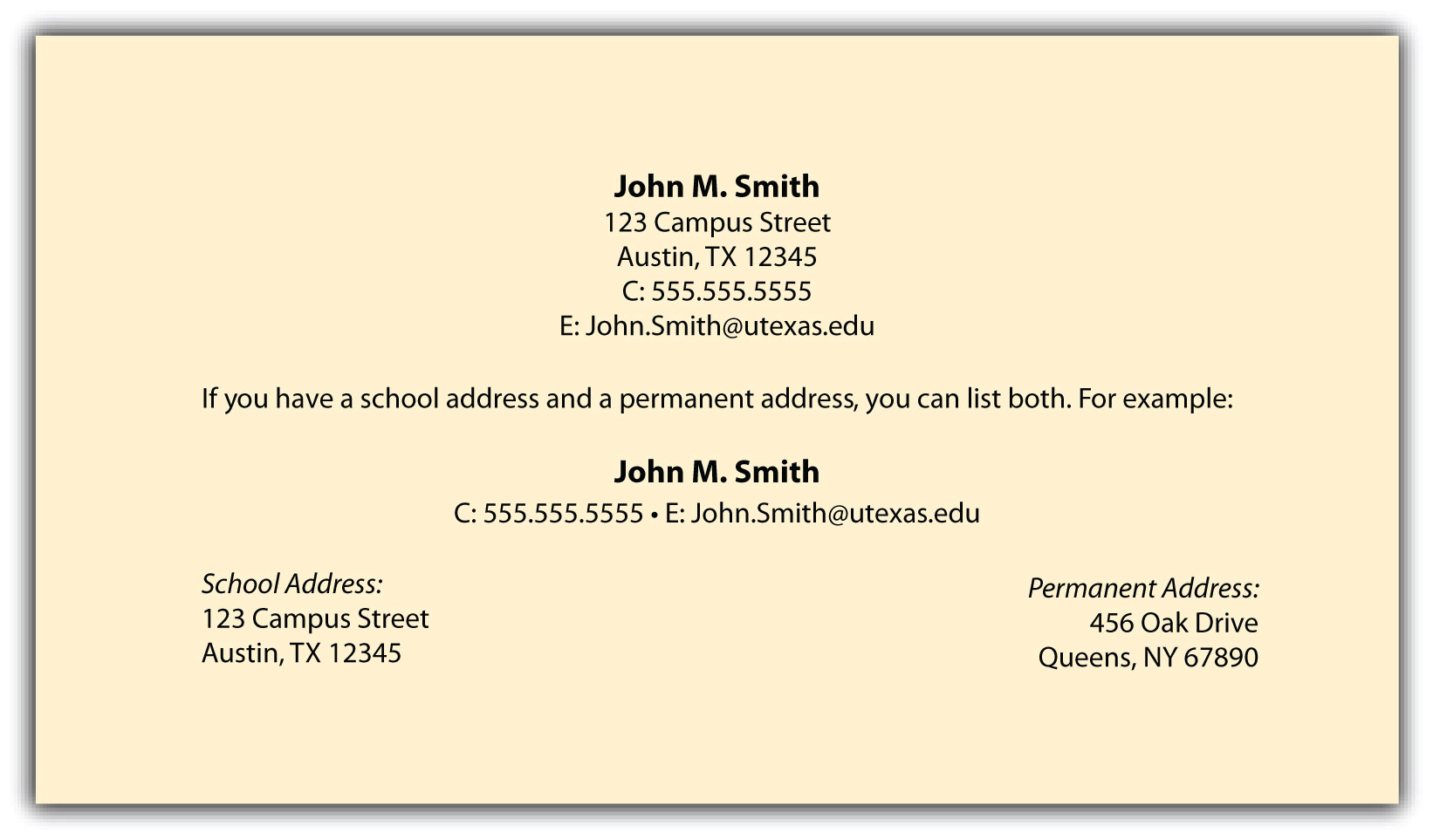
Your E-mail Address
Have a professional e-mail address because employers frown upon unprofessional addresses such as greeneyes2@gmail.com or runningguy62@verizon.net. It’s best to use your first name and your last name in a simple e-mail format.
Establish a professional e-mail address as soon as possible (e.g., c.thompson@gmail.com or e.autoris@verizon.net). It’s much more relevant than c.thompson@rutgers.edu, especially if you graduated six months earlier. If you continue your job search after graduation, you might not be permitted to use your school e-mail address, nor should you once you have graduated. Given this, obtaining a professional e-mail address is a good networking opportunity to contact the individuals with whom you’ve been in touch regarding your job search. Inform those individuals and any relevant recruiters that you’ve updated your contact information.
Your Phone Number
Include only one phone number on your résumé and record a professional voice mail. Do not play music on your voice mail. and speak clearly and succinctly. It’s also recommended that you not answer your cell phone if you are in a loud area, especially when you do not recognize the number. Allow the call to go to voice mail, listen to it in a quiet place, and return the call as soon as possible. It very well could be a recruiter who would not be impressed by you shouting, “What? I can’t hear you!” A professional voice mail might sound like the following: “You’ve reached John Smith at 555.555.5555. Please leave a message and I will call you back as soon as possible.”
Include your name and repeat the phone number to help the recruiter know for certain that the proper person has been reached. Clarity is always helpful and appreciated. Lastly, be sure to check your voice mail on a regular basis, even if you are on vacation.
Objective
Recruiters appreciate clarity, and an objective can help a recruiter understand exactly what you offer or what business would best suit your background. Objectives can be very targeted and mention a specific position or can be a bit broader in describing a job function. Whatever objective you choose, it should state what you are looking for and what you have to contribute. It’s not only about you. It’s about what you can do for them. Here are some examples of effective objectives:
- An entry-level accounting position in audit, allowing me to use my analytical and detail orientation to ensure accuracy in all reports and reviews.
- A communications internship at a top media company that will allow me to use my knowledge and experience to produce and edit clear and effective communications.
- An entry-level position in the health-care industry, enabling me to use my business and communications skills to enhance a company’s bottom line.
- A full-time marketing position at a Fortune 500 company, enabling me to utilize my knowledge and experience to enhance marketing efforts firm-wide.
Your objective should not ramble past two lines because no recruiter appreciates reading a paragraph-sized objective.
Using the four preceding items, Figure 4.2 "Sample Résumé—Header and Objective" illustrates how our sample résumé looks thus far.
Figure 4.2 Sample Résumé—Header and Objective
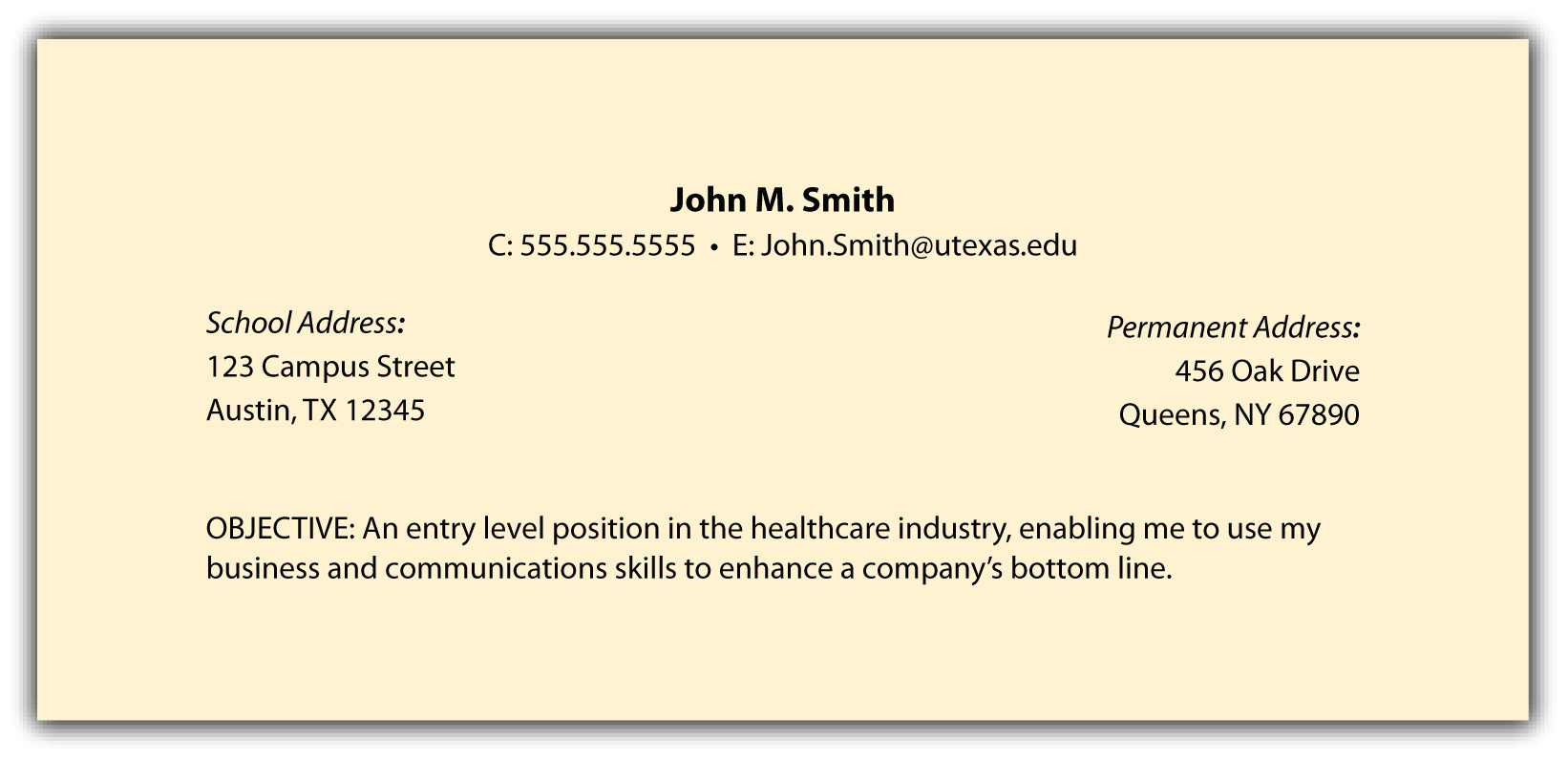
Key Takeaways
- A header is the first thing a recruiter sees on your résumé. This information should make a strong and professional impression of your candidacy.
- A professional voice mail recording is critical to being considered for a position.
- An objective should be clear and succinct, allowing the reader to understand what type of position you are looking for.
Exercises
- Draft the header to your résumé, including all core components.
- Create professional voice mails for your cell phone and your home phone if they will be used for your job search.
- Create a professional e-mail address separate from your school e-mail address, unless you already have one. This is especially important when you enter your senior year.
- Draft two objectives: one that references a specific job and another that references an entry-level position in a certain industry.
4.3 Education Section
Learning Objectives
- Learn how to present your education to position you for success with your résumé reader.
- Include vital information regarding your GPA, major and minor selection, and extracurricular activities so prospective employers can get a sense for your focus.
While you are in school, or up to one year after you graduate, your education section should appear before your experience section. Once you are a working professional, these two sections can and should be flipped.
Additional items in this section include the following:
- Expected graduation date: Listing the month or the season both work well here (e.g., Spring 2013 or May 2013).
- Relevant coursework: You may choose to list relevant coursework if it pertains to the position for which you are applying.
- Major and minor: You may choose to include both your major and your minor.
- GPA: You may include your overall GPA or you may decide to list the GPA of your major. It’s recommended that you not include your GPA if it is below 3.3. Certain industries are more concerned with GPA than others, including consulting, investment banking, and trading, which can require a 3.6 or 3.7 and above. It’s best to research each industry to better familiarize yourself with such requirements because this can vary by industry and by company.
- Extracurricular activities: Recruiters may be impressed to read that you were active in your college and that you belonged to targeted student clubs. If you held any leadership posts, that information should be included as well.
- Study abroad: If you have studied abroad, list that here. You should include the name of the university, the city and country, and the coursework.
Nontraditional college students (those who have significant work experience and then decide to obtain their degree) may want to list experience before education. Since this is unusual for a new graduate, you should consult with either career services or a career coach regarding this résumé order.
Here is an example of how to list your education information.
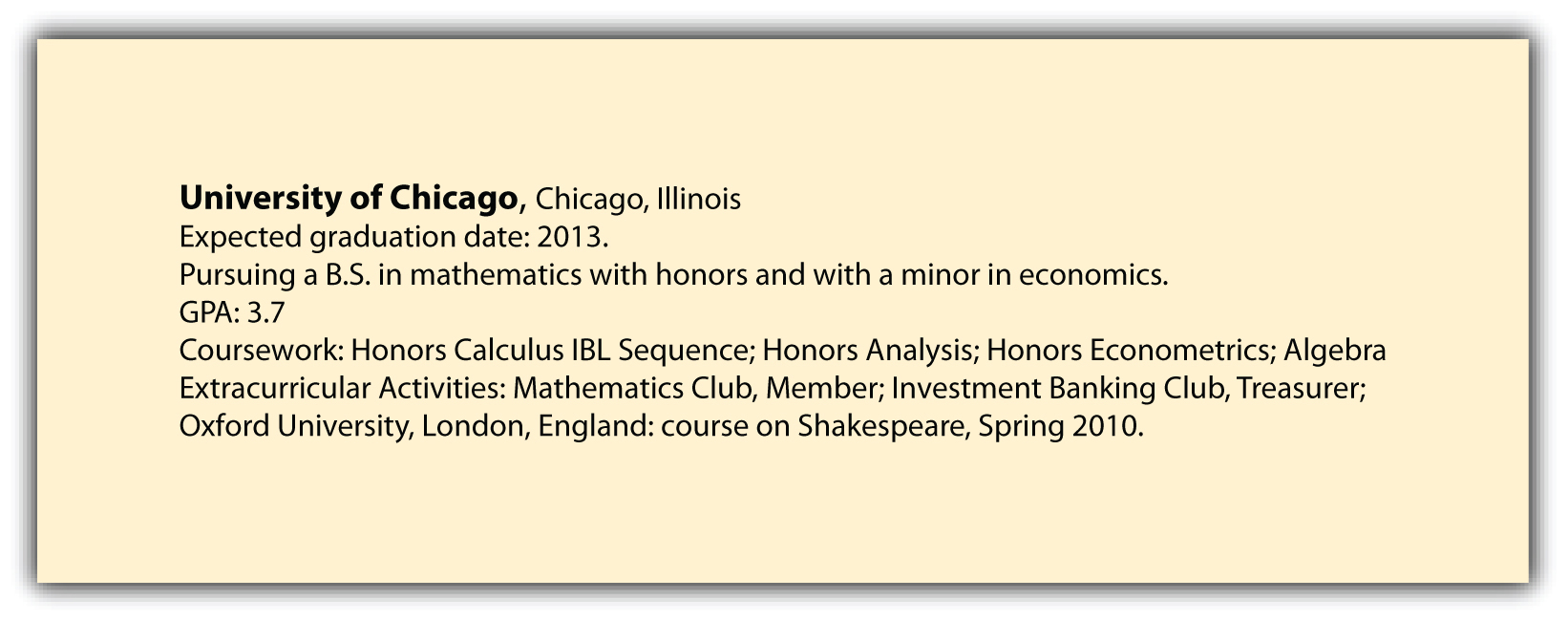
If you attended only one college, only that college should be listed in this section.
If you transferred from another college, you should list both schools in this section. The first school you list is the current school you attend, followed by the previous school. If and when you attend graduate school, law school, and so forth, your postgraduate school would then be listed first.

High schools, no matter how prestigious, should not be included in a résumé.
If you’ve received additional training and certifications, this information does not belong in your education section. Instead, it can be listed in skills and additional information, which will be reviewed in the section of this chapter titled “Skills, Additional Information, and References.”
Using the preceding information, Figure 4.3 "Sample Résumé—Header, Objective, and Education" illustrates what our résumé looks like thus far.
Figure 4.3 Sample Résumé—Header, Objective, and Education

Key Takeaways
- Your education section should clearly list your college(s) and include a number of important details, including GPA, majors and minors, and extracurricular activities.
- Your candidacy can be enhanced by including supporting coursework, so include that as well.
Exercises
- Create your education section, using the details listed in this chapter.
- Include all important aspects of this section: your expected year of graduation, GPA (if over 3.3), major and minor, relevant coursework, and extracurricular activities.
- Pair up with someone in your class, review their information, and critique it to make the section better.
- Have your classmate review your work by critiquing it so you can enhance your education section.
4.4 Work Experience
Learning Objectives
- Understand that your work experience is perhaps the most important part of your résumé because it bridges the gap between being a college student and becoming a potential employee.
- Include quantified, results-oriented information in your bullets to help engage your prospective employer.
This section is arguably the most important of your résumé because most recruiters look for past work experience as a predictor of future work experience. The most conventional method of listing your work experience is in opposite chronological order (as with your education section). List your most recent job experience first and include the following information:
- The name of the company
- The city and state and, when outside the United States, the country
- The years of employment (If you’ve had several jobs at one company, include the overall years of experience, and for separate jobs, note specific years of experience.)
- Three to seven bullet points describing your responsibilities and the results of your work, depending on the number of years of experience
It’s important to use bullet points because they clearly and succinctly list your responsibilities and achievements. Recruiters do not enjoy or appreciate reading long paragraphs because they want to quickly skim the information.
Action verbs are helpful in this section of your résumé. You may want to consider the following words.
|
|
|
Bullets should be results oriented and used to help quantify as many things as possible. Earlier in this chapter, we referenced the following examples:
- Reducing errors by 35 percent
- Increasing profits by 25 percent
- Boosting repeat sales to 75 percent
Here is how these items can be put into bullets:
- Reduced errors by 35 percent by creating an Excel program that immediately highlights inconsistencies when raw data are entered into the system.
- Increased profits by 25 percent by gathering best practices and creating a training program for all new hires.
- Boosted repeat sales by 75 percent by delivering the very best customer service, as evidenced by numerous satisfaction letters and comments to senior management.
Work experience comes in many forms. The majority of your experience will be paid, but it’s fine to include unpaid work experience. Perhaps you had an unpaid internship working in the marketing department of a magazine. Absolutely include that in your work experience. Perhaps you volunteered to help a teacher organize their classroom, and perhaps you interacted with students and helped them be prepared for the lesson plan. Include that in your work experience. The bottom line here is that through every experience, either paid or unpaid, you learn something. If you are washing cars, you learn the value of a production line: someone washes, someone rinses, and someone receives the payment. It’s fine to list work experiences such as babysitting, where your bullet could read as follows:
- Managed three to four hours of after-school activities for three children ages seven to eleven, ensuring homework was completed accurately and efficiently.
You may work in a grocery store and include the following information in your bullet:
- Assisted dozens of customers daily with all aspects of the store’s retail offerings, including answering questions about the locations of items and checking out customers quickly and efficiently at the register.
Sample résumés are included the end of this chapter. Refer to them when drafting your résumé as some have quite a bit of related work experience, some have very little, and others have international exposure. Each sample will give you an idea of how to craft your résumé for your job search.
Key Takeaways
- Your work experience section is one of the most important on your résumé because recruiters will review this in light of the opportunities they have available.
- No matter what the type of position, it’s important to quantify information and your accomplishments. The clearer your experience, the easier it will be for a recruiter to match you to a position.
- Bullet points are preferred when drafting your responsibilities and accomplishments. Recruiters can easily review bullet points versus reading long, drawn-out paragraphs.
- A results-oriented résumé is preferred. Include how you helped your employer succeed and grow.
Exercises
- Review some of the résumés at the end of this chapter.
- Record all of your work experiences, starting with your most recent.
- Use three or four bullet points for each experience.
- Try to tie as many of your responsibilities as possible to the company’s or organization’s bottom line.
- When writing your bullet points, remember to be results oriented.
- Draft a résumé using what you learned in this section, and pair up with someone in this class. Review and critique their information and have them do the same for you. This should strengthen your résumé overall.
4.5 Skills, Additional Information, and References
Learning Objectives
- Provide your skills and additional information to offer another dimension of your candidacy, one that can resonate with your résumé reader.
- Communicate with your references in advance because references are a vital part of the job search process and can position you for success.
Skills and Additional Information
This section of your résumé should include, but not be limited to, the following information:
- Computer skills: Most employers expect Microsoft Word, Excel, and PowerPoint, but include additional software knowledge (e.g., Dreamweaver).
- Language skills: Include your honest level of fluency (e.g., Spanish, fluent, French, beginner).
- Community service: Include any volunteer work, such as park clean-ups, walk-a-thons for various causes, fundraising events of any kind. Be specific about your responsibilities and your results including: dollars raised, hours spent, leadership position, end-user experience (e.g. fund-raising efforts reached over $20K, providing for five developmentally disabled students and their parents to travel to Florida to swim with the dolphins.)
- Interests: This information can help to build rapport with interviewers. It’s best to keep it simple and include things that are truly of interest to you such as reading, movies, and physical fitness (in general) or tennis, football, softball (specifically). It’s true that the “Interests” section is not a core piece of information, but the vast majority of interviewers enjoy reviewing this, and the rapport you build can be helpful!
You can include additional information:
- Licenses and certifications: Individuals can achieve literally hundreds of professional licenses in the areas of health care, finance, real estate, insurance, and so forth. For a complete list, Google professional licenses, and you will be able to identify if you should include any on your résumé. Examples include Chartered Financial Analyst (CFA)To become a CFA, a person needs to take the course and pass it through the CFA Institute. This course is known to be rigorous, but you can benefit from it in the long run because you will be a respected securities professional. Level I, Licensed Real Estate Agent, and so forth.
Important note: Never misrepresent any information on your résumé. If you have knowledge of another language, qualify your knowledge as fluent, intermediate, or beginner. If you don’t speak a language other than English, do not include a bullet point about language because you might not know the language capabilities of your interviewers.
Some résumé readers differ on this, but listing your interests can help develop rapport with your résumé reader and interviewer. No matter what the skill level of the interviewer, having a common interest can always begin a great conversation.
An example of information listed in this section could include the following.

References
One of the famous last lines of a résumé is “References furnished upon request.” This is not necessary because employers can simply ask for references when they want them. However, a proactive, impressive strategy would be to create a single-page document that includes the following information:
- Your header (so it’s a matched set with the résumé), including your name, address, and contact information
- Your reference’s name
- Your reference’s company and title
- Your reference’s relationship to you (e.g., manager, peer, vendor, and so forth)
- Your reference’s contact information, including their e-mail address and phone number
Do not widely distribute this information because it contains the contact information of your references, which you should treat as confidential. However, having the list prepared enables you to quickly share this information with prospective employers upon request.
Help your references help you by notifying them that they can expect a call and by highlighting the most important qualities you want them to mention.
An example of this document could include the following.

Key Takeaways
- Skills and additional information add another dimension to any résumé. Recruiters should know your computer skills and any language skills you may have. This section of your résumé also presents a great opportunity to share information about any community service work you’ve done.
- Listing your interests often helps build rapport with recruiters and interviewers.
- Misrepresenting your accomplishments or abilities is unethical. Many otherwise-qualified candidates often find themselves in uncomfortable positions when they have misrepresented even the slightest item on their résumé.
- The names of your references do not belong on a résumé.
- It’s not necessary to include the line “References furnished upon request.”
- Having a reference document is very helpful when conducting a proactive and efficient job search.
Exercises
- Draft this section of your résumé and include all the details mentioned in this chapter.
- Qualify your computer and language skills as fluent, familiar, or having some knowledge. If you speak only one language, don’t include this information on your résumé.
- Identify three or four individuals who can serve as your references, and get their permission to give their names and contact information to prospective employers.
- Speak to your references in advance and let them know about your career goals and which companies you are targeting. You may also ask that they emphasize one particular skill over another (e.g., that you pay great attention to detail or have strong analytical skills).
- When you are interviewing with a specific company, let your references know in advance that they may be contacted, and ask that they let you know if they are contacted.
- Thank your references.
4.6 Other Résumé Formats, Including Functional Résumés
Learning Objectives
- A chronological résumé has the most-expected résumé format, and while it’s good to give a résumé reader what they expect, it’s also helpful to know about other types of résumé formats.
- A functional résumé highlights skills versus specific work experiences.
- A functional résumé can be used when you think employment gaps or the lack of employment can hurt your candidacy.
Functional Résumés
This chapter thus far has reviewed a résumé that follows a chronological format. Another format to consider is a functional résuméAs opposed to a chronological résumé, offers a different emphasis on a candidate’s accomplishments and background., which highlights the skills you’ve developed more than the individual jobs you’ve held.
Functional résumés can be different from what most recruiters will review, so it’s best to proceed with care. This includes consulting a career services office and consulting a professional résumé writer.
It’s important to note that throughout the many, many years that individuals have been drafting résumés, recruiters have expected to see a chronological résumé with certain sections: employment, education, and additional information. In most cases, it’s best to give recruiters what they expect: a chronological résumé.
With that understood, functional résumés can be used for college students and experienced candidates for the following reasons:
- Individuals may want to highlight their skills and achievements rather than the companies for which they worked.
- College students who do not have a strong work experience history can use a functional résumé to give them a chance to include other achievements, honors, and abilities in a very pronounced way.
- Experienced individuals can deemphasize gaps in employment because recruiters often notice gaps and then want those gaps explained.
- Experienced individuals can also deemphasize career mobility and emphasize skills and achievements.
Here are some categories you may want to consider when drafting a functional résumé:
- Communication skills
- Teamwork skills
- Leadership skills
- Honors and special achievements
- Athletic involvement and achievements
- Volunteer experiences
Figure 4.4 "Sample Functional Résumé 1" and Figure 4.5 "Sample Functional Résumé 2" are examples of how a functional résumé might look.
Figure 4.4 Sample Functional Résumé 1
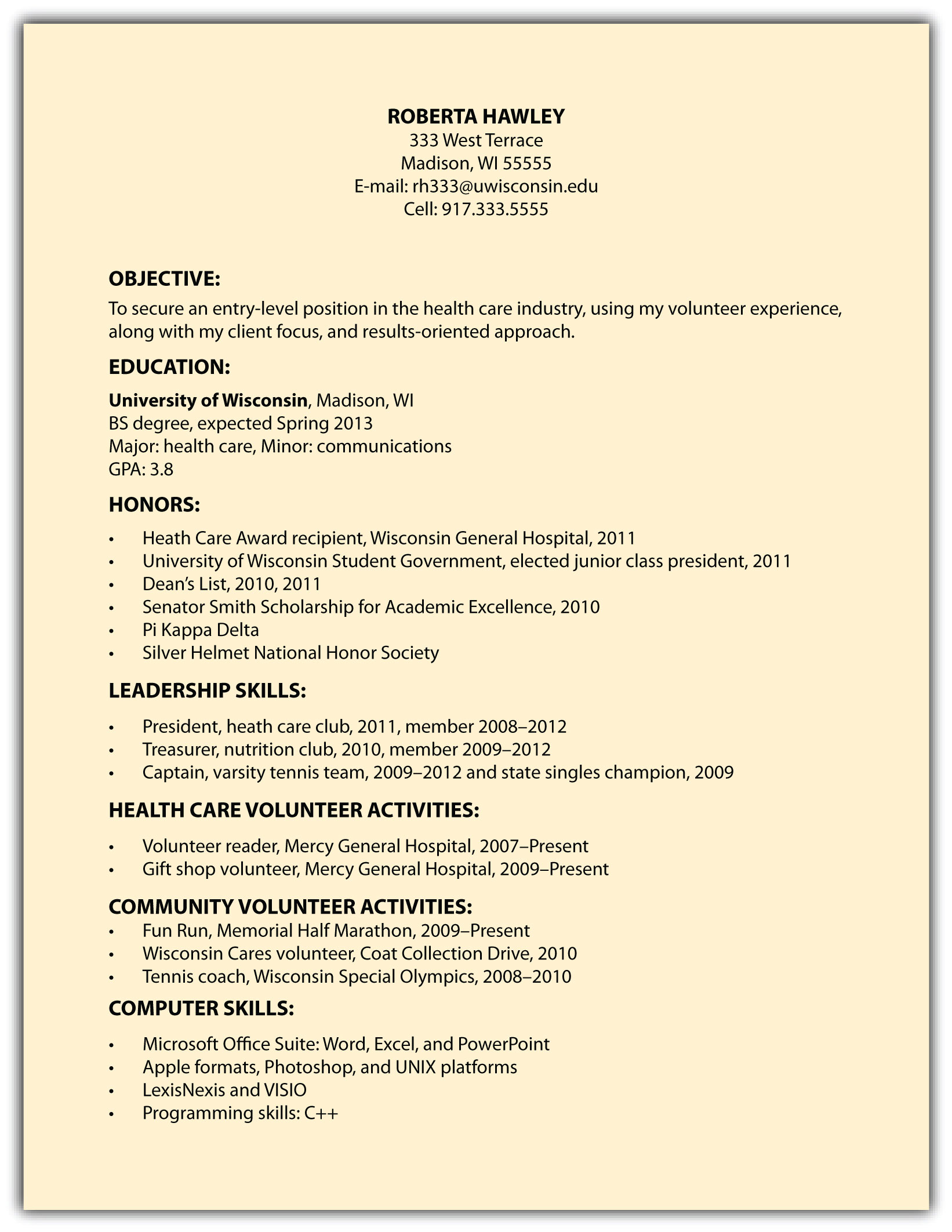
Figure 4.5 Sample Functional Résumé 2
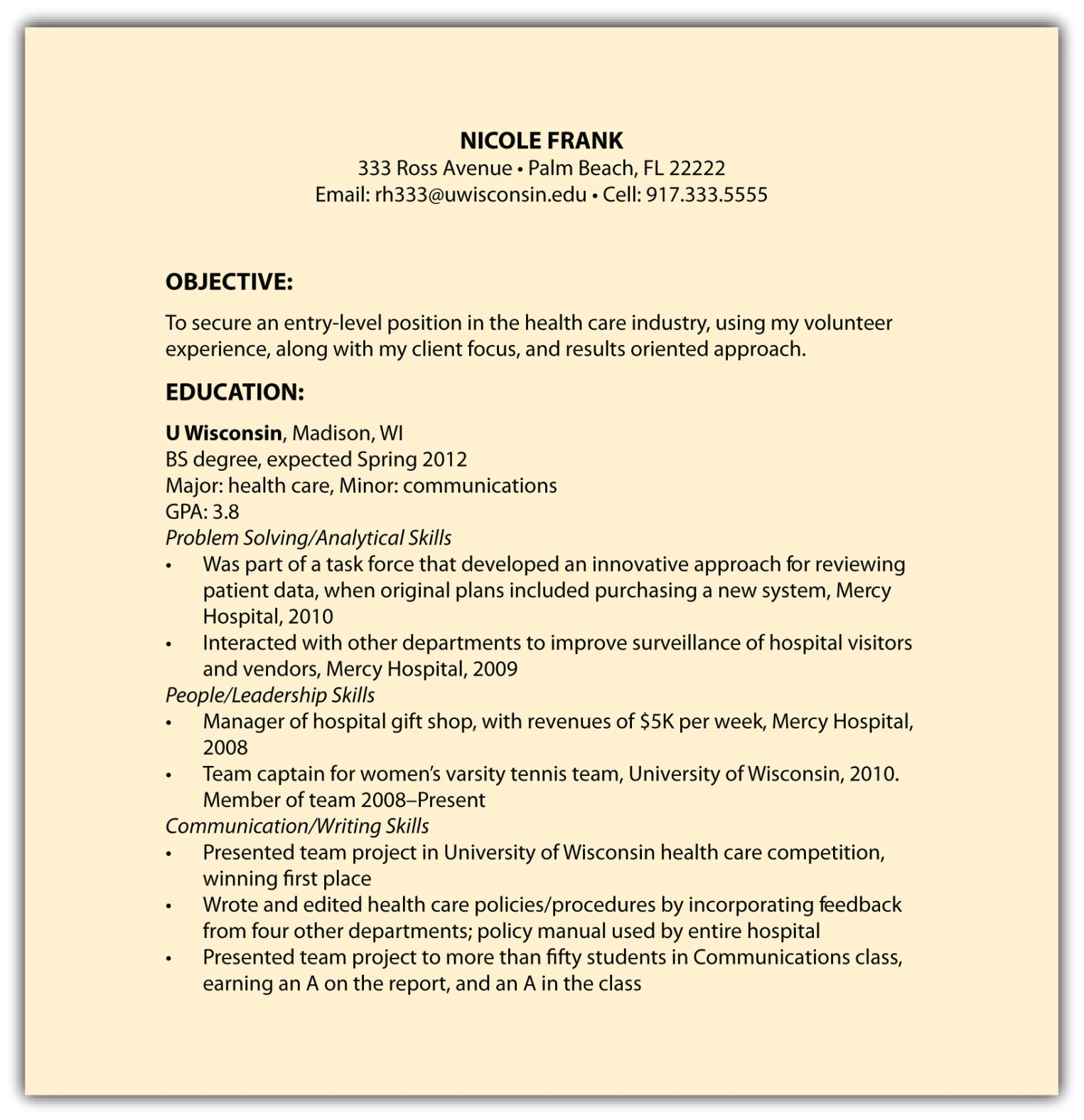
Curriculum Vitae (CV)
Some people interchange the word résumé with curriculum vitae (CV)Used internationally, particularly for research-oriented positions. A CV is often longer and more detailed than a résumé., which is incorrect because they are different items. A CV is mostly used internationally, particularly for research-oriented positions. A CV is often longer and more detailed than a résumé. In some cases, CVs are six to eight pages long and include published material and conference information if the person presented information to colleagues. A CV may or may not include biographical information, including marital status and nationality (this is typically the case with international students studying in the United States).
With this said, a résumé is the appropriate document when seeking any nonacademic or nonclinical position in the United States. If you are interested in working overseas, use research to familiarize yourself with an employer’s expectation regarding résumés, CVs, and additional information.
Key Takeaways
- Functional résumés are not what most recruiters expect, but they have certain advantages that can help your candidacy.
- Functional résumés highlight specific strengths rather than the name of the company for which you worked.
- CVs are very different from résumés because CVs, which often are used for research-oriented positions, can sometimes be six to eight pages in length.
Exercises
- Think about how you would construct your résumé in a functional format versus a chronological format.
- Decide which format works best for you: chronological or functional.
- Review and critique this information with a classmate.
4.7 Documenting Problems: Gaps, Short Stints, and Merging Companies
Learning Objectives
- Learn to properly explain any time gaps in your résumé because recruiters have a trained eye and often notice gaps in employment and jobs of short duration.
- Learn how to position companies that have merged with other companies.
Gaps
Recruiters carefully review résumés and will notice any gaps in either employment or education. While rare, any anomaly should be addressed. For example, perhaps a student was ill for half a semester and didn’t graduate in the expected year. Perhaps they had an opportunity to live in another country for a prolonged period of time. A résumé will state the timeline, but the cover letter can be used for more of an explanation. It’s best to consult a professional because this situation can be a bit of a minefield.
Short Stints
Recruiters appreciate longevity at a company. If you’ve worked two summers at the same company, that proves your worth to your employer because they rehired you. If you’ve jumped from one company to another in short periods of time, that can be considered a disadvantage.
Merging Companies
A list of the top one hundred companies today is vastly different from a list of the top one hundred companies from ten years ago. If you worked for a company that has now merged with another company and no longer has the same name, simply list the name of the new company and put the previous company’s name in parentheses. Here is an example:
Pfizer (premerger Warner-Lambert), New York, New York
Key Takeaways
- Recruiters review a résumé in seven to ten seconds, yet are trained to identify gaps of any kind.
- Recruiters appreciate candidates who have repeat work experiences at a certain employer, such as working at one company for two consecutive summers.
- Companies often merge with other companies, so note the new name first and put the company’s original name in parentheses.
Exercises
- Review your résumé with a critical eye toward gaps of any kind: gaps in employment and gaps in your educational experience.
- Consider how you would explain any existing gaps to a recruiter.
- Practice your explanation with a classmate and have them critique your response.
- Meet with someone at your career service office for a mock interview, and have them specifically ask about any gaps in your résumé.
- Seek out someone in the profession in which you are most interested, and ask if they are willing to review your résumé to help you improve it. It’s very helpful to get an industry professional’s advice.
4.8 Chapter Review and Exercises
Creating a compelling marketing campaign is a vital step in your job search because it helps you market your skills and abilities to future employers before you meet them. It’s a critical link in the six-step job search process. Take great care in creating each of the four components:
- A résumé
- A cover letter
- A pitch
- An online profile
Your résumé is clearly the cornerstone of your marketing campaign because it sells your candidacy. It also serves as a one-page summary of your strengths, abilities, job responsibilities, educational background, and much more.
The more care you put into writing your résumé, the greater your chances of being noticed by the employer of your choice. The best strategies for writing a résumé are the following:
- Be clear, concise, completely accurate (in terms of grammar and content), and results-oriented.
- Quantify whatever accomplishments you can.
- Proofread your résumé with someone who knows what a résumé should look like and contain.
It’s also important to know that while a résumé is a critical piece of your job search, it alone will not get you an interview or a job. A résumé, at best, is subjective, and different individuals have different preferences regarding format, font, length, typeface, and content. Following the guidelines of this chapter can only help position you best for success.
The remaining elements of your marketing campaign will be covered in the following chapter; each element will continue to strengthen your marketing campaign and ultimately, your job search success. Creating your compelling marketing campaign will be more effective when you are more specific, targeted, and thoughtful:
- Your résumé will prove your success to your past employers, which then proves your worth to your future employers.
- Your cover letter makes the case for why you should be hired because it highlights the two or three critical skills necessary to succeed in the job in which you are most interested.
- Your pitch allows you to introduce yourself in a clear and concise way, highlighting the strengths that will enable you to succeed.
- Your online profile works behind the scenes so you will be noticed by recruiters who seek talent, and also provides a great way to stay connected with your network.
Step 3 is research, which will enable you to gather vast amounts of information about your industry, your function, your geography, and the companies you are targeting.
Chapter Takeaways
- A compelling marketing campaign is vital to your job search and is composed of four things: a résumé, a cover letter, a pitch, and an online profile.
- Your marketing campaign must have high-quality standards because it represents you when you are not there.
- Your résumé is the cornerstone of your marketing campaign, and it positions you for success.
- A well-written résumé can do seven specific things for you and your job search.
- A résumé should include the following sections: header, objective, education, experience, skills (computer and language, when appropriate), and additional information that may include community service, certifications, and interests.
- Bullets in your work experience section should outline your responsibilities and your accomplishments in a clear, results-oriented manner.
- Action verbs should be used to describe your responsibilities.
- Résumés can be presented in two formats: a chronological format and a functional format. Both have advantages and can be used by college students and more experienced candidates.
- A CV is very different from a résumé. CVs are used quite a bit internationally, often for research or clinical positions. CVs also can be six to eight pages in length and include biographical information such as marital status and country of origin.
- Recruiters are trained résumé screeners and actively look for gaps in employment, in addition to short periods of employment.
- Ask three or four individuals to act as references. Proactive candidates create a reference document that lists the names and contact information of people who will serve as positive references.
Chapter Review
- How can a résumé market you as a candidate?
- What are the two most important things a résumé must be?
- What are the main things a résumé can do for you?
- What are the most important sections of a résumé?
- Why would you use an objective on your résumé?
- What should you record on your voice mail?
- Why should you not pick up your cell phone if you are in a noisy place, especially if you don’t recognize the number?
- Why are action verbs important?
- Why is it important to quantify your accomplishments?
- Why is it helpful to be results oriented?
- Why is it important to include skills, certifications, and interests on your résumé?
- What is the difference between a chronological and a functional résumé? What are the advantages of each type?
- What is the difference between a résumé and a CV?
- Why do recruiters care about short stints at employers and any gaps in employment?
- What is the most productive way to present references to a prospective employer?
- How can you keep your references up to date regarding your job search?
SuccessHawk: Résumés
For tips and ideas about creating your résumé, go to the menu bar at the right and click on Résumés in the advice and research section. (Note: There is a charge of $9.95 for use of the Résumé Creator.)
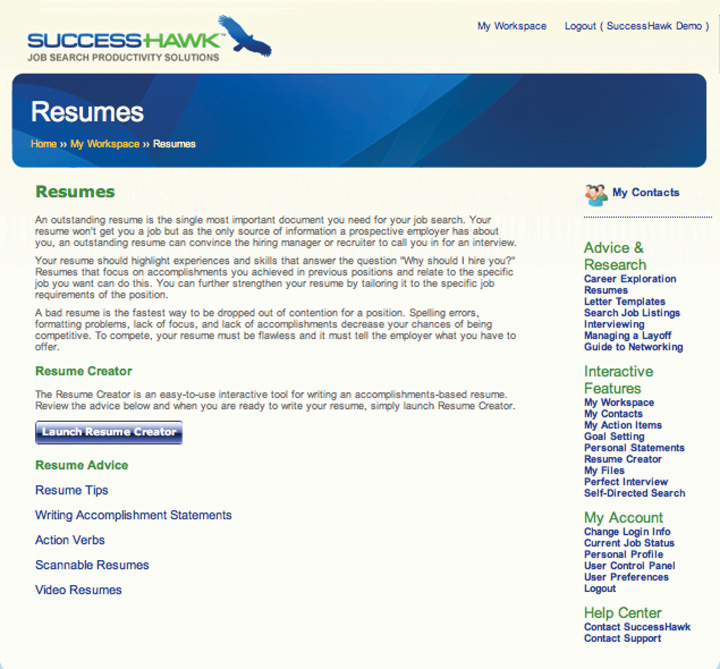
4.9 Sample Résumés
Figure 4.6 Sample #1—Brian Thanis

Figure 4.7 Sample #2—Alyse Day
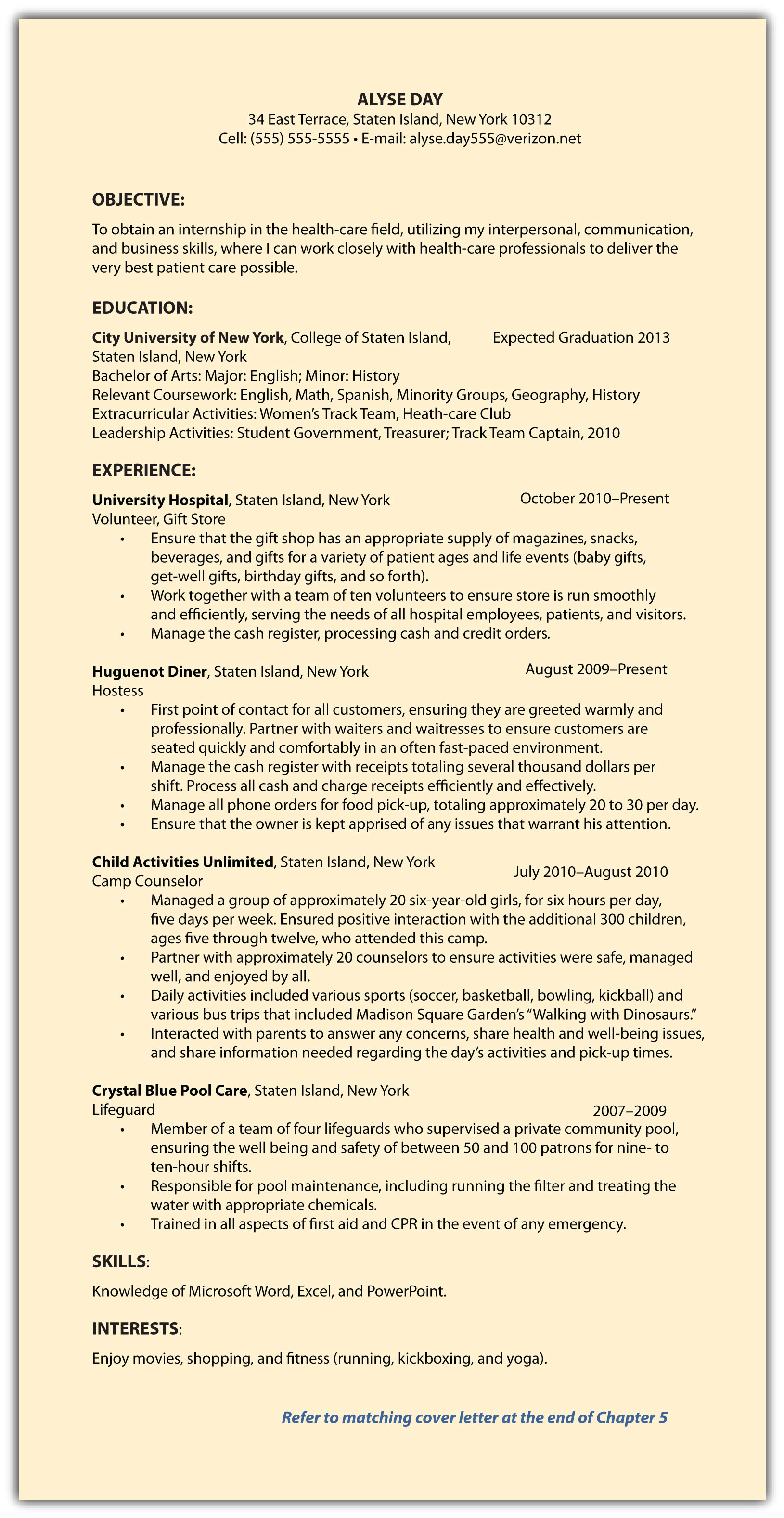
Figure 4.8 Sample #3—Brittany Post

Figure 4.9 Sample #4—Donna Right
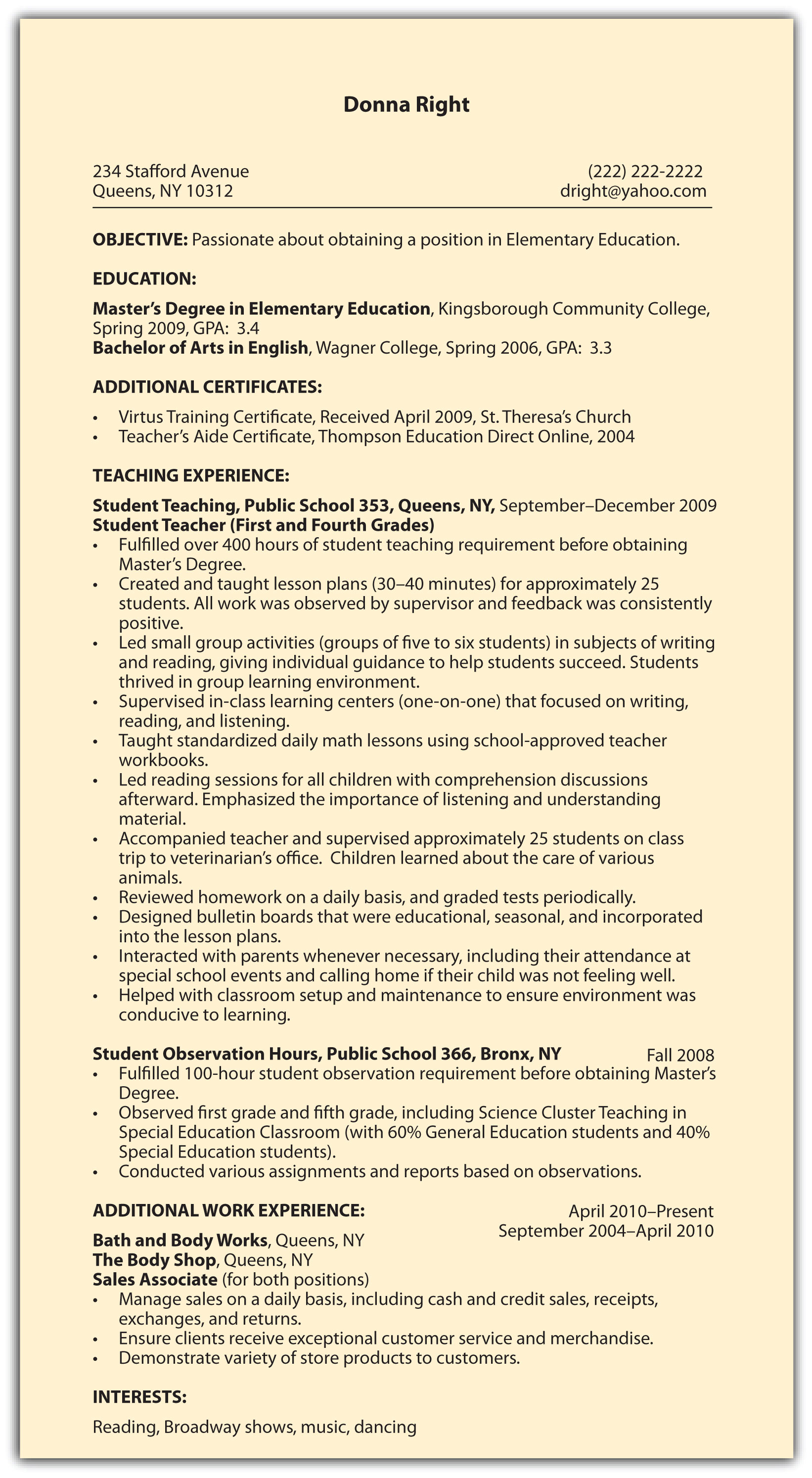
Figure 4.10 Sample #5—April Stream
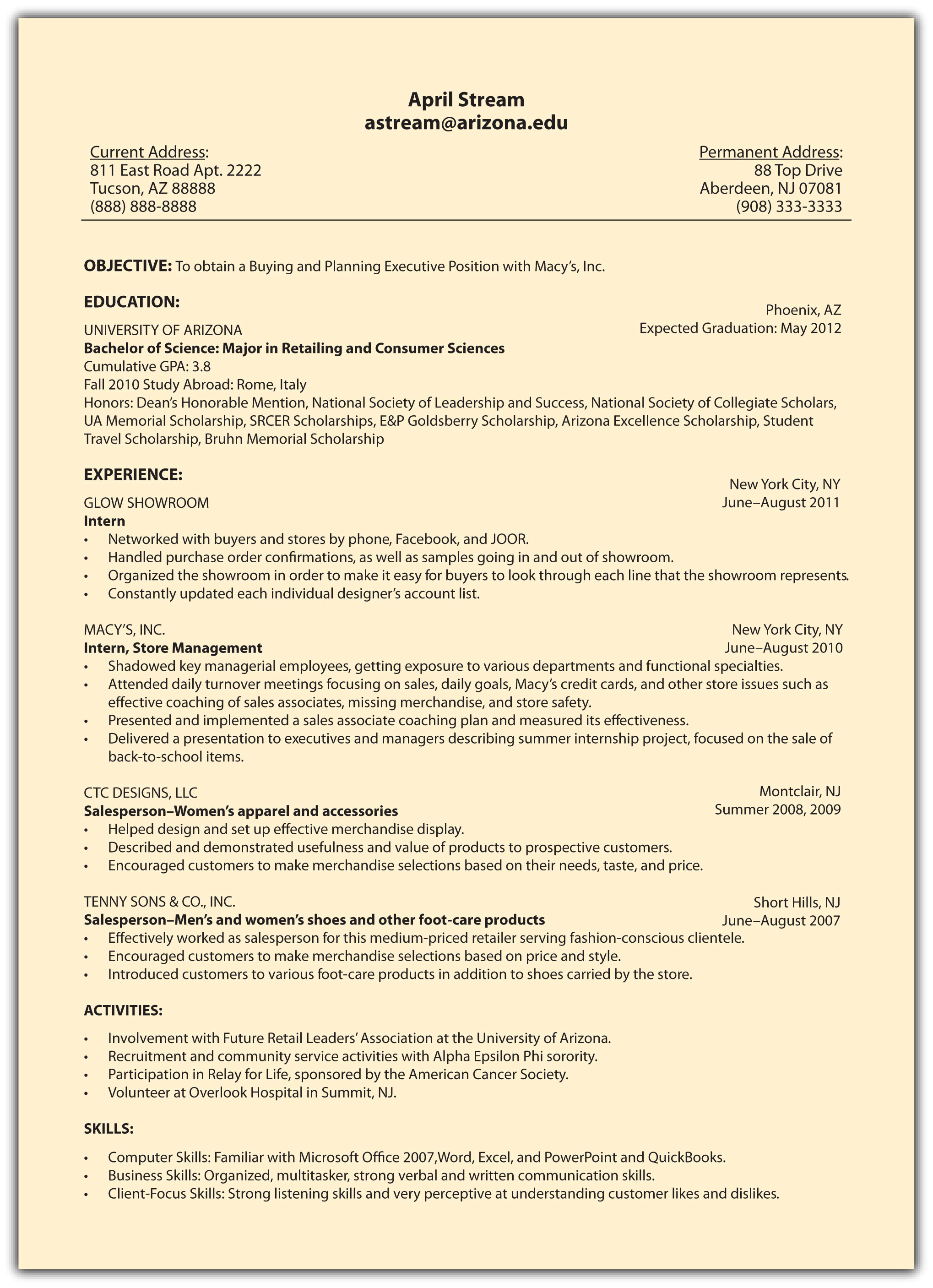
Figure 4.11 Sample #6—Louise Ng
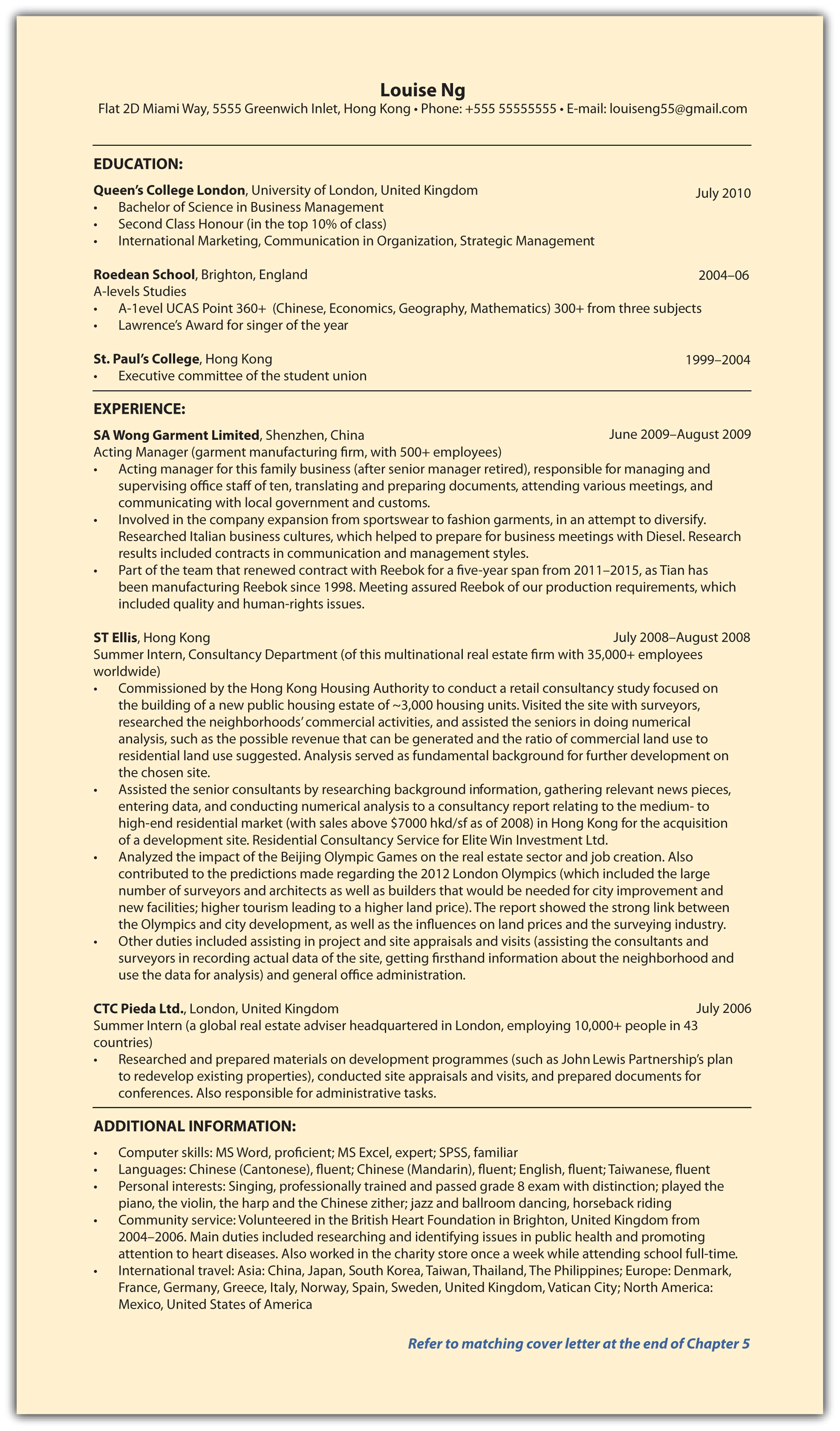
Figure 4.12 Sample #7—Helen Patty





